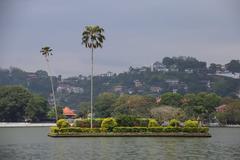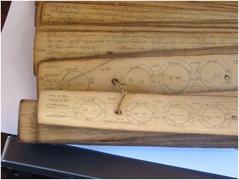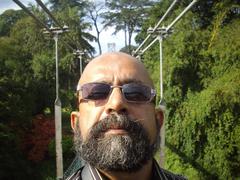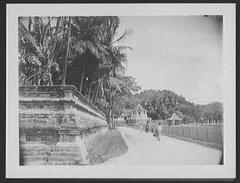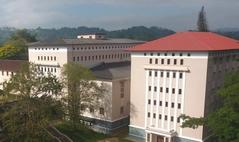
Degaldoruwa Raja Maha Vihara: Visiting Hours, Tickets, and Historical Significance in Kandy, Sri Lanka
Date: 04/07/2025
Introduction
Just outside the vibrant city of Kandy in Sri Lanka’s Central Province lies Degaldoruwa Raja Maha Vihara—a remarkable cave temple celebrated for its integration of Buddhist spiritual traditions, royal heritage, and outstanding Kandyan-era artistry. Carved into a massive granite outcrop, this 18th-century monument was commissioned by King Kirti Sri Rajasinha and completed by his successor, King Rajadhi Rajasinha, as part of a broader revival of Buddhism during a period marked by colonial encroachment. The temple is renowned for its exquisitely preserved murals depicting Jataka tales and offering rare insights into Kandyan society. Only 6–10 kilometers from Kandy’s city center, Degaldoruwa offers both accessibility and tranquility to visitors seeking cultural, historical, and spiritual enrichment.
This guide offers a comprehensive overview of the temple’s history, architectural features, visiting hours, entrance policies, accessibility, travel tips, and nearby attractions—ensuring you have all the information needed for a rewarding visit. For up-to-date details, consult resources such as the Sri Lanka Department of Archaeology, Tourslanka, and Lonely Planet.
Table of Contents
- Introduction
- Historical Background and Cultural Significance
- Architectural and Artistic Highlights
- Visiting Degaldoruwa Raja Maha Vihara
- Frequently Asked Questions (FAQ)
- Conclusion and Further Exploration
- References
Historical Background and Cultural Significance
Royal Patronage and the Kandyan Kingdom
Degaldoruwa Raja Maha Vihara’s origins are deeply entwined with the religious and cultural resurgence of the late Kandyan Kingdom. Construction began in 1771 under King Kirti Sri Rajasinha, a monarch instrumental in revitalizing Sri Lankan Buddhism amid colonial threats. The temple was completed by his brother, King Rajadhi Rajasinha, and entrusted to the monk Moratota Dhammarakkita Nayaka Thera. This period witnessed a determined effort to safeguard Buddhist traditions and foster artistic innovation (Sri Lanka Department of Archaeology; Tourslanka).
Etymology and Site Selection
The name “Degaldoruwa” derives from Sinhala words meaning “rock” and “crack,” describing its unique setting in a fissured granite outcrop. This natural fortress not only protected the temple’s delicate murals but also symbolized the harmonious integration of architecture with the surrounding landscape—a hallmark of Kandyan temple design (ForeverVacation).
Architectural and Artistic Highlights
Cave Temple Structure
Unlike many cave temples that adapt natural caves, Degaldoruwa was meticulously hewn from solid rock, exemplifying both ingenuity and reverence. Key features include:
- Mandapa (Entrance Chamber): Showcases intricate woodwork and the makara thorana (dragon arch).
- Vihara Geya (Image House): Houses prominent Buddha statues, including a reclining Buddha symbolizing Parinirvana and a seated meditative Buddha.
- Stupa and Bo Tree: Situated atop the rock, reinforcing the temple’s spiritual significance.
Murals: Masterpieces of the Kandyan School
Degaldoruwa is internationally acclaimed for its vivid murals, completed in the late 18th century by Devendra Mulachari and his team of “Sittara” painters. These tempera paintings—created with natural pigments on dry plaster—depict key Jataka tales (Vessantara, Sattubhatta, Satusoma, Mahaseelava), scenes from the Buddha’s life, and the dramatic Mara Yudde (Buddha’s encounter with Mara). The murals are distinguished by:
- A flat, decorative style using a limited palette of reds, whites, yellows, and blacks.
- Continuous narrative sequences separated by natural motifs.
- Detailed representations of contemporary attire, customs, and social life.
These paintings are both religiously significant and invaluable to historians studying the Kandyan era (Tourslanka; eLanka).
Visiting Degaldoruwa Raja Maha Vihara
Visiting Hours and Tickets
- Opening Hours: Daily, typically from 6:00 AM to 6:00 PM (Holidify).
- Tickets: No official entry fee; donations are encouraged to support maintenance and conservation. Foreign visitors may occasionally be asked for a nominal contribution (Lonely Planet).
Getting There and Accessibility
- Location: Degaldoruwa Raja Maha Vihara is in Amunugama, about 6–10 km southeast of Kandy (Srilankan Guide).
- Transport Options: Tuk-tuk or taxi from Kandy (20–30 minutes); public buses toward Amunugama with a short walk to the temple.
- Parking: Available near the entrance.
- Accessibility: Expect steps and some uneven terrain. Assistance may be available, but certain areas may challenge visitors with limited mobility.
Travel Tips and Visitor Etiquette
- Dress Modestly: Shoulders and knees must be covered. Remove shoes and hats before entering shrine areas.
- Photography: Permitted outside; inside, restrictions protect the murals. Ask temple staff for current guidelines.
- Best Time to Visit: Early morning or late afternoon to avoid heat and crowds, especially during the drier months from December to April.
- Guided Visits: Resident monks often provide informal explanations. For in-depth tours, local guides can be arranged in Kandy.
Additional Tips:
- Bring socks for comfort on hot stone surfaces.
- Carry small cash for donations.
- Respect ongoing rituals and observe quietly.
- Do not touch murals or statues—this helps with conservation (TripVenture).
Nearby Attractions
Take full advantage of your visit by exploring other Kandy historical sites and natural attractions:
- Temple of the Sacred Tooth Relic (Sri Dalada Maligawa): Sri Lanka’s most venerated Buddhist site and a UNESCO World Heritage location.
- Royal Botanical Gardens, Peradeniya: Renowned for its diverse plant collections and serene landscapes.
- Lankathilaka Viharaya & Gadaladeniya Rajamaha Viharaya: Ancient temples known for their unique architecture and murals.
- Kandy Lake & City Centre: Ideal for a relaxing stroll or local shopping.
- Udawattakele Sanctuary: Popular for birdwatching and nature walks.
- British Garrison Cemetery: Offers a glimpse into colonial-era history.
- Hanthana Mountain Range: Perfect for hiking and scenic views (Sri Lanka Travel Notes; DestGuides).
Frequently Asked Questions (FAQ)
Q: What are Degaldoruwa Raja Maha Vihara’s visiting hours?
A: Daily from 6:00 AM to 6:00 PM.
Q: Is there an entrance fee?
A: No official fee, but donations are appreciated.
Q: Are guided tours available?
A: Resident monks often give informal tours; dedicated guides can be arranged in Kandy.
Q: Is the temple accessible for those with mobility issues?
A: Some areas involve steps and uneven rock; accessibility is partial.
Q: Is photography allowed inside?
A: Generally discouraged inside the shrine to protect murals; always check with staff.
Conclusion and Further Exploration
Degaldoruwa Raja Maha Vihara stands as a living testament to Sri Lanka’s Buddhist devotion, royal patronage, and artistic achievement. Its unique rock-cut architecture and vibrant Kandyan-era murals make it an essential stop for anyone exploring the region’s cultural heritage. The temple’s peaceful setting and accessibility from Kandy allow for a rich, contemplative experience—especially when combined with visits to nearby historical sites.
Visitors are encouraged to observe local customs, contribute to preservation efforts, and seek out local insights for a deeper understanding. For further information, download the Audiala mobile app and explore related content on Sri Lanka’s Buddhist and Kandyan heritage.
References
- Sri Lanka Department of Archaeology
- Tourslanka
- ForeverVacation
- Lonely Planet
- Srilankan Guide
- Amazing Lanka
- Holidify
- eLanka
- DestGuides
- TripVenture
- Sri Lanka Travel Notes
- Trek Zone




